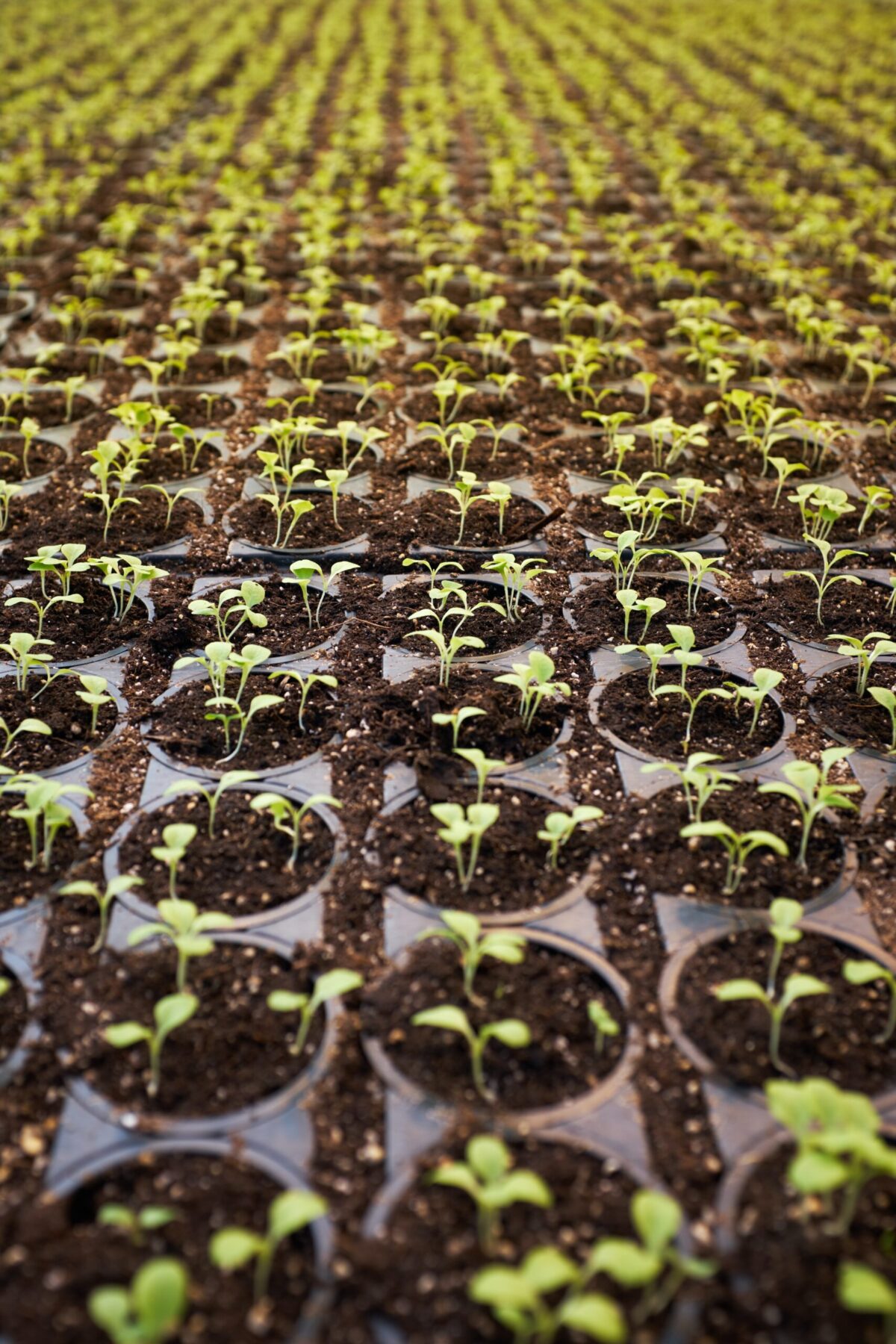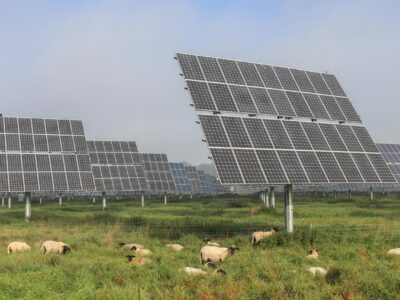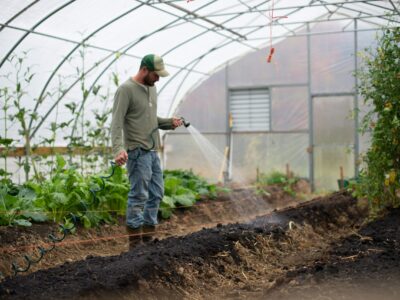May 27th, 2020
While hydroponics may not be a household word just yet, it’s cropping up in high school hallways, repurposed shipping containers, rooftop gardens and across many dinner tables in America. At Disney World’s “Living with the Land” exhibit, plants are grown magically (or hydroponically), with no soil to anchor the roots. Vertical farming takes the phenomenon even further, growing plants in tiny boxes stacked the length of a skyscraper. Images of “Little Shop of Horrors” crossed with “The Matrix” come to mind, but the word hydroponic is actually quite down to earth, rooted in the good old fashioned Latin words “hydro” meaning water, and “ponos” meaning labor.
Dating back to 1699, when John Woodward managed to grow spearmint seemingly out of thin air (and water), the U.S. Army developed hydroponic methods to grow food for troops stationed in the infertile Pacific islands during World War II. The 1940s brought glasshouse hydroponics and by the 1950s, hydroponic farming had found its way into commercial agriculture in the United States. Who wouldn’t want to develop state-of-the-art techniques for producing food in a soilless setting? Think of the possibilities!
But first, let’s break down the process. What exactly is it? Hydroponics is a method of growing plants in water with a cocktail of nutrients and a controlled environment. A science of possibility, hydroponics can flourish in a myriad of locations, including places that can’t support traditional agriculture like the desert, the mountains or the middle of Manhattan. Easy to grow crops include nutrient-rich tomatoes, cucumbers, peppers, lettuce, herbs and strawberries. Hydroponic farming is fast and efficient — lettuce can be grown and harvested in under three weeks. And it scales, with the vertical farming practice of growing produce in stacked layers, individual growers in Houston and Oasis Biotech and Get Fresh in Las Vegas are benefiting from the versatility of hydroponics.
A largely sustainable practice, hydroponic agriculture is not dependent on changes in weather or soil health. Often consumed locally, hydroponic farming serves the rising trend of knowing where our food comes from. Though often applied in small urban settings to a limited scale, the agricultural industry is cashing in on vertical farming, developing everything from harvesting robots, automatic seed planters and greenhouse roof washers. This growth has led to a reduction in operating costs and an increase in revenues, making hydroponic produce more affordable for grocers and restaurants to offer. All of this combined creates an ecosystem of fresh abundance, and in a time of shrinking economies and shifting climates, this promising method of putting food on the table is looking better than ever.
How the Economy Grows Hydroponically
There was a time when the “business of hydroponics,” may have conjured images of a local green thumb fussing over his potted plants to sell a few tomatoes at the local farmer’s market. But times have changed. Today, hydroponic farming is a state-of-the-art technology, producing food in controlled, soilless settings to enormous scale. The practice of vertical farming is growing the market exponentially, supporting the larger agricultural economy in the United States. In 2018, North America’s vertical farming market was valued at $959.1 million, with the U.S. dominating 64.5 percent. Revenue for the hydroponic industry continues to climb, meeting the demands of farmers to replace crops damaged by extreme weather. The weather factor alone is enough to guarantee a steady increase projected through 2023, as downstream purchasers become reliant on hydroponic farmers, and vegetable prices rise. Add to this the growing desire for fresh, local produce, and the trend toward urban dwelling, and you’ve got a clear forecast for success in an industry known to be highly unpredictable.
So who’s testing it for us? Last year, Oasis Biotech built one of the largest indoor hydroponic vertical-farming facilities in the United States, and they built it in Las Vegas. According to Michelle Howell, the company’s sales and marketing manager, they Las Vegas was a safe bet due to its status as a “food mecca and tourist destination,” And, oddly, the climate was a draw: “If we can make this concept work in the middle of a desert that reaches 100-plus-degree temperatures most of the year, we can make it work anywhere.” They’re now producing 1,500 pounds of pesticide-free greens a day using 90 percent less water than a traditional farm, in a 215,000-square-foot facility with LED lighting using 50 percent less energy than high-pressure sodium lights. And they deliver from harvest to plate in under 48 hours.
Oasis partnered with Get Fresh, a local food distribution company which then brought in a more homespun venture, Green Sense Farms from Indiana. Long known as a pioneer in hydroponics, Green Sense Farms is now building a 20,000-square-foot indoor-vertical farming facility outside of Vegas that will produce one million heads of lettuce and one million herb plants annually. Meanwhile, down in Kentucky, Hydroponic Farms USA is set to build a 42-acre facility this year to grow a cornucopia of fruits and vegetables, as well as feed for their livestock 365 days a year. It’s a closed-loop system in the best of ways for farmers like Hydroponic Farms USA. But it opens to include all of us. With a skyrocketing global population, our need for food is projected to double by 2050, as farmland continues to diminish. Will hydroponics save us, and the market too? It just might.
Hydroponics: A Future for Generations to Come
COVID-19 has changed the world. We’re gardening to stay sane. We’re growing food in high school hallways to feed our communities. Well, maybe not all of us, but that’s what many kids these days are up to, thanks to programs like the FFA that are putting an emphasis on hydroponic farming. In 1988, the Future Farmers of America changed its name to the National FFA Organization “to better reflect the expanded agricultural opportunities encompassing science, business and technology, in addition to production farming.” Hunger is one of the biggest problems we face globally, and compounded with the joint health and economic crises of the pandemic, we need innovation and sustainability in our food supply now more than ever. FFA thinks hydroponics can help and their hypothesis is working its way across America in fresh healthy produce from Brooklyn to Milwaukee, and D.C to Wichita. It’s more than a fad. It just might keep us fed.
When D.C. Everest Senior High School in Weston, Wisconsin shut down for the pandemic, its agriscience program went into high gear. Only four months old, the school’s hydroponic vertical zip farm is now producing over 4,000 lettuce plants at a time to help feed their community. This is all done with no soil, very little water, some select nutrients, and high efficiency LED lights, making it a sustainable win-win.
So should hydroponics be a part of our national curriculum? Jay Super, a science teacher at Maize High School in Kansas, says yes, and the proof is in the pudding, or salad, in this case. To access the state’s career and technical education incentives, Super launched an agricultural science pathway with an advisory board assembled from the farming industry. The board mandated that the school start an FFA chapter. According to the U.S. Census of Agriculture, the number of farms in the United States continues to decline, but FFA membership is on the rise, with 32 percent of student participants living in urban and suburban areas. This is right in line with Maize High School as 90 percent of its students come from the city. While Kansas has been called the breadbasket of the world, most of its urban inhabitants have little to no understanding of modern agricultural practices, making conditions ripe for an education in hydroponics.
Maize High School received a $12,500 Farm to School sub-grant to grow food that would be served in its cafeteria. With the help of FFA, Super has not only built a hydroponics farm in his high school hallway, he’s instilling the future of food in passionate young minds, ready to tackle the hard stuff, like sustainability, world food insecurity and socioeconomic development through innovative agriculture. The future is our youth and our youth have hydroponics.





